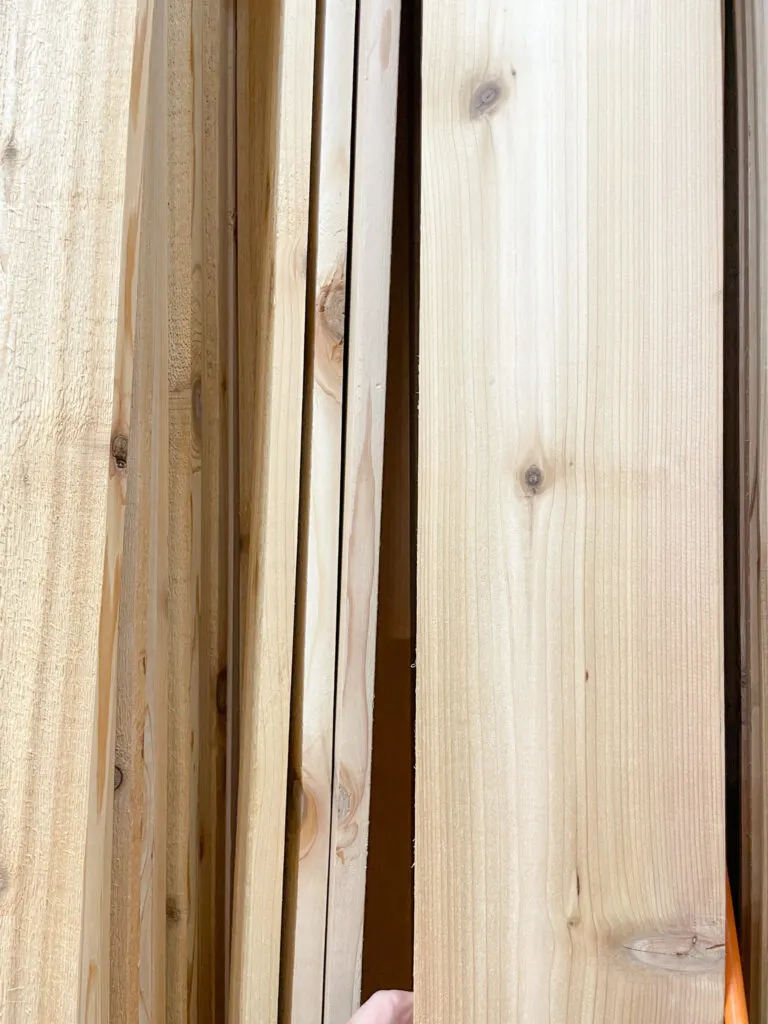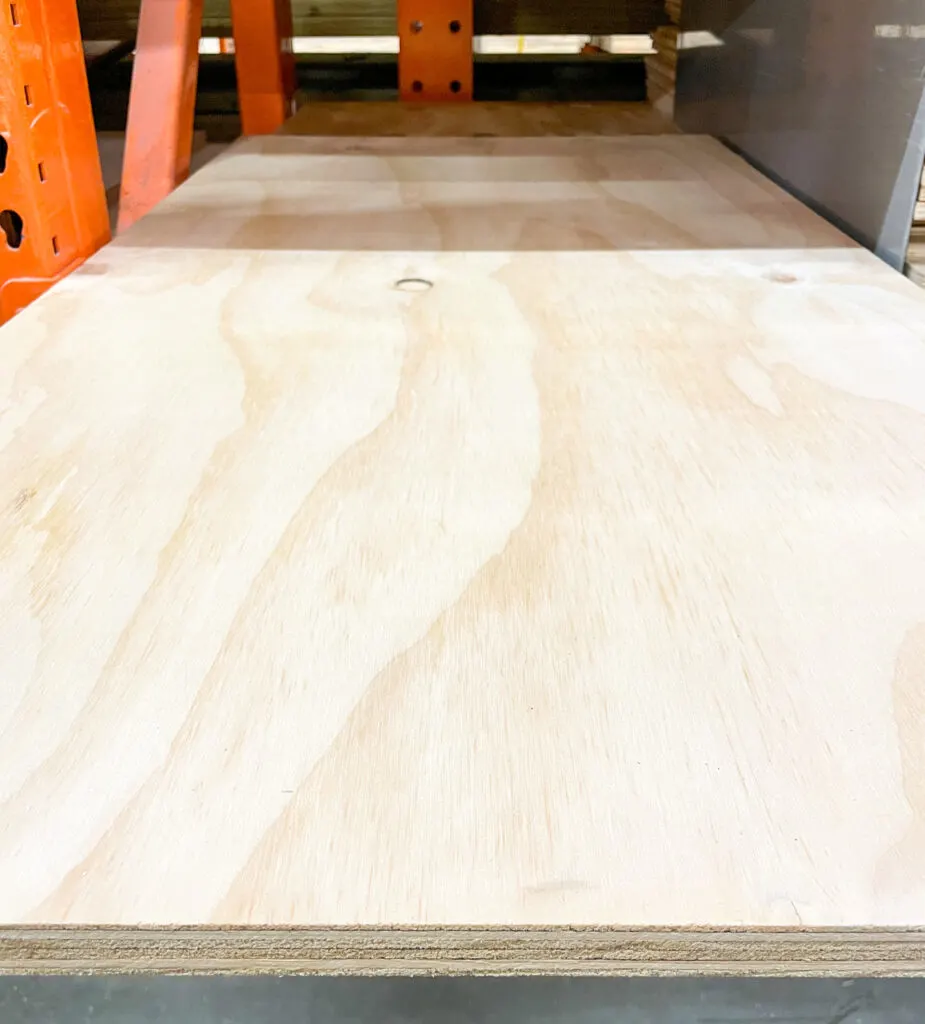Chances are if you’ve landed on this page you are looking to make your own DIY furniture. I’m no stranger to pulling out some scrap wood and creating a fun furniture piece. It can be both rewarding and cost-effective. There is a little research that needs to go into selecting the ideal wood, as this determines the furniture’s durability, appearance, and overall quality.
There is a myriad of wood species available for DIY furniture, and each has its unique properties, making it suitable for different pieces. Whether it’s a rustic coffee table, a sleek bookcase, or a charming dining set, I’m hoping to layout the best wood for your DIY project.
I’ve also got a more specific post if you are looking for the best wood for a DIY desk.
In this post, we will discuss various wood species that excel in furniture-making and explore their distinct qualities, touching upon factors such as strength, stability, and ease of work.

Table of Contents
Understanding Wood Types
When it comes to DIY furniture, selecting the right type of wood is crucial for both aesthetics and durability. There are two main categories of the different types of wood: hardwood and softwood. Hardwoods are sourced from deciduous trees, such as oak like red oak, maple, and walnut, while softwoods come from coniferous trees, like pine, cedar, and spruce.
Hardwoods are generally denser and more durable than softwoods, making them suitable for high-traffic furniture like tables and chairs. Some popular hardwoods for furniture making include:
- Oak: Highly durable and resistant to wear, with a beautiful grain pattern
- Maple: Dense and strong, available in a variety of lighter shades
- Walnut: Rich, dark color, and fine-grained, used for luxurious furniture pieces
On the other hand, softwoods are less dense and more affordable, making them ideal for less demanding applications where visual appeal is essential. Common softwoods for DIY furniture include:
- Pine: Lightweight, easy-to-work-with, and takes stain or paint well
- Cedar: Aromatic, naturally resistant to decay, and often used for outdoor furniture
- Spruce: Strong and budget-friendly, typically used for structural support
Aside from these main categories, there is also plywood and MDF (Medium Density Fiberboard). Plywood is composed of thin layers of wood veneers bound together with adhesive, making it versatile and strong. MDF, a composite material, is made of wood fiber mixed with resin and is suitable for painted furniture pieces.
Check out the following factors when choosing between these wood types:
- Durability: Hardwoods are more durable, but for lighter-duty furniture, softwoods may be sufficient.
- Aesthetic: Choose a wood with a grain pattern, color, and texture that matches your design vision.
- Workability: Some woods are easier to work with, affecting the time and effort required during the DIY process.
- Cost: Evaluate your budget and weigh the benefits of each wood type to strike a balance between quality and affordability.
Softwoods for DIY Furniture
Pine
Pine wood is a popular choice for DIY furniture projects due to its affordability and easy-to-work-with nature. It is lightweight and offers a range of colors from pale yellow to light brown. Its softness allows for simple cutting and shaping, making it perfect for beginners. Below are some common types of pine for DIY furniture:
- White Pine: Known for its straight grain and even texture, it’s ideal for cabinetry and furniture frames.
- Yellow Pine: With a distinct grain and more durability, it’s great for flooring and outdoor furniture.
Don’t forget to properly seal and finish pine furniture. This will not only enhance its natural beauty but also protect it from potential damage and wear.

Cedar
Cedar is another softwood widely used in DIY furniture-making, mainly for its aromatic properties and natural resistance to moisture, decay, and insect damage. It has a fine, straight grain with a uniform texture and a reddish-brown color. Years ago you would often see closets made with cedar boards. There are two primary types of cedar used in furniture making:
- Western Red Cedar: Commonly used for outdoor furniture due to its weather resistance and appealing color.
- Aromatic (Eastern Red) Cedar: Known for its strong scent and moth-repellent properties, it is suited for indoor furniture like wardrobes, chests, and lining drawers.
Cedar requires a proper finish, especially for outdoor furniture, to maintain its durability and appearance. A sealant or an oil finish will preserve cedar’s natural qualities while providing protection against the elements.

Spruce
Spruce is another softwood that is suitable for DIY furniture projects. It is mainly used for construction purposes, such as framing, but its strength, uniform texture, and light color make it an attractive option for lightweight furniture pieces. Some popular types of spruce are:
- Sitka Spruce: Known for its strength-to-weight ratio, it is commonly used in making musical instruments and furniture parts.
- Norway Spruce: Offers excellent workability and finishing properties, making it a good choice for cabinetry and indoor furniture.
Similar to other softwoods, it is crucial to apply a proper finish to spruce furniture pieces to prevent damage from moisture and enhance their appearance.
Hardwoods for DIY Projects
Choosing the right hardwood for your DIY furniture project is crucial to achieve the desired look and durability. Below we’ll discuss four primary hardwood options: Oak, Maple, Walnut, and Cherry.
Oak
Oak is a popular choice for furniture making due to its attractive grain pattern and the fact that it’s a very durable wood. It comes in two types: red oak and white oak. Both options are durable, but white oak is more resistant to moisture, making it an excellent choice for outdoor furniture and wood flooring.
- Durability: High
- Workability: Moderate
- Color: Light to medium brown
- Grain pattern: Pronounced, attractive

Maple
Maple is another excellent option for DIY furniture projects. It is known for its hardness, making it resistant to wear and tear. There are two primary types of maple: hard and soft. Hard maple is the more robust option, while soft maple offers greater workability.
- Durability: High
- Workability: Hard (difficult), Soft (moderate)
- Color: Light, creamy color
- Grain pattern: Fine, uniform
Walnut
Walnut is an elegant and versatile hardwood that has a beautiful color and grain. It is relatively easy to work with and makes for stunning furniture pieces.
Cherry Wood
Lastly, cherry is a popular choice for its attractive grain and warm, reddish hue. It is a moderately hard wood that becomes darker and richer in color over time.
Composite Woods and Their Uses
When it comes to DIY furniture, composite woods are a popular and affordable choice. These engineered wood materials, available in a variety of forms, provide different benefits depending on your project requirements. Let’s talk about three common types of composite woods: plywood, MDF, and particle board.
Plywood
Plywood is a versatile and strong composite wood made by gluing together thin layers of wood veneers. Each layer, or ply, is arranged with the wood grain running perpendicular to the adjacent layer, increasing its overall strength and stability. Plywood is available in various thicknesses and the rankings are listed below.
From highest quality to lowest, here’s what to look for with grades of plywood:
- “A” Grade. Sanded smooth, paintable
- “B” Grade. Solid surface with some repairs, usually football-shaped patches and/or wood filler
- “C” Grade. Tight knots to 1-1/2 in
- “D” Grade. Knots and knotholes up to 2-1/2 in.

Shown above is a lower grade of plywood with minimal repairs.

Above is a higher grade (more smooth, less knots) of plywood that is considered sandable and paintable. This type of grade of plywood is used for shelving and other home projects.
Advantages
- Strength: Plywood’s cross-layered structure provides excellent strength and resistance to warping.
- Flexibility: Thin plywood sheets can be bent, making it suitable for curved designs.
- Finish: Higher-grade plywood has a smooth surface, allowing for easy painting or staining.
Common uses
- Shelving
- Cabinetry
- Tabletops and countertops
Check out a handful of DIY open shelving ideas here (most of them being made from plywood or MDF).

MDF
Medium Density Fiberboard (MDF) is a dense and smooth composite wood produced by combining wood fibers with wax and a resin binder under high pressure. MDF provides an ideal surface for painting, as its fine texture is free of knots and grain patterns found in natural wood.


Advantages
- Smooth surface: MDF’s consistent texture makes it an excellent choice for paint-grade projects.
- Easy to work with: MDF can be easily cut, drilled, and routed without splintering or chipping.
- Affordability: MDF is less expensive than many solid wood options.
Common uses
- Painted piece of furniture
- Cabinet and wardrobe doors
- Decorative trim and molding
Particle Board
Particle board, also known as chipboard, is a composite material made from wood chips, sawdust, and a binder, pressed together under heat. Although not as strong as plywood or MDF, particle board is a cost-effective alternative for projects where strength is less of a concern.
Advantages
- Affordability: Particle board is generally the most inexpensive composite wood option.
- Lightweight: The low density of particle board makes it easy to handle and transport.
Common uses
- Furniture components (e.g., back panels and drawer bottoms)
- Low-weight shelving
- Substrate for laminate or veneer surfaces
Factors to Consider When Choosing Wood
When selecting the best wood for your DIY furniture project, several factors should be taken into consideration. These include durability, workability, cost, and aesthetics.
Durability
One of the critical factors to consider when choosing wood for DIY furniture is durability. Different wood species have varying degrees of strength and resistance to wear, decay, and insect damage.
- Hardwood option; oak, maple, and walnut tend to be more durable than softwoods.
- Softwood option; pine, cedar, and spruce are generally less resistant to wear, but may be suitable for certain applications.
Workability
Another essential factor is workability – the ease of working with the wood using tools and fasteners. Some wood types are more straightforward to cut, shape, and finish than others.
- Hardwoods like maple can be challenging to work with due to their density, but provide excellent results when properly processed.
- Softwoods like pine are more forgiving when worked with hand tools, but may require extra care with power tools to avoid damage.
Cost
Cost is always an important consideration when selecting wood for a DIY project. The price of wood can vary significantly depending on factors such as species, grade, and availability.
- Economical options like pine or poplar can be a great choice for budget-conscious projects.
- Premium species like oak or walnut may be more expensive but can offer improved durability and a high-end appearance.

Aesthetics
The aesthetic appeal of the wood is crucial, as it will impact the final appearance of your furniture. Wood species vary in color, grain pattern, and texture, making some more visually appealing than others.
- Woods like cherry wood and walnut wood have rich, warm colors and attractive grain patterns, making them popular choices for furniture.
- Lighter-colored woods such as pine and ash can provide a more modern, Scandinavian-style look when finished with a clear coat.
Select a wood type that complements your desired furniture design and personal preferences.
Finishing and Treatment Options
Staining
Using a stain product is an excellent choice to enhance the natural beauty of your DIY wooden furniture. Diverse wood species, such as oak, maple, and pine, react differently to stains, so choose the right type of stain for your project.
- Water-based stains: These are eco-friendly, dry quickly, and offer easier cleanup. However, they might raise the wood’s grain, making sanding necessary.
- Oil-based stains: These penetrate deeper into the wood, creating a richer color and offering longer protection. They take longer to dry and require mineral spirits for cleanup.
Always test the stains on scrap pieces or hidden areas of your furniture to confirm the final color and finish.
Find related posts about staining and stain products below:
The BEST Light Wood Stain Colors
Best Colorful Wood Stains for Vibrant and Long-lasting Wood Finishes
Weathered Oak Stain On Pine; Minwax vs. Varathane
Is there a White Wash Stain for Wood?
4 Common Types of Wood Stain with Product Examples
Valspar One-Coat Exterior Solid Stain & Sealer Review
Ten Easy Gel Stain Cabinet and Furniture Projects
How to Stain Wood Stairs Treads without Sanding
Wood furniture Makeover with Unicorn SPiT as a Gel Stain in Three Easy Steps
How to Apply Wood Stain over Wood Stain
Wood Dye vs. Wood Staining; How and When to Use Each
How to Stain Wood with Household Products
Sealing
Sealing your wooden furniture is crucial for protecting it from moisture, dirt, and damages. A variety of sealers are available on the market, such as:
- Polyurethane: This sealer provides a durable finish, either in a gloss or matte appearance. It is available in water-based and oil-based formulas. Water-based polyurethane is low-odor and easy to clean, while oil-based polyurethane provides a warmer, amber finish but has a stronger smell.
- Shellac: A natural, non-toxic product made from secretions of the lac bug. It provides a glossy finish and is excellent for sealing and protecting the wood. However, shellac may not be suitable for high-moisture areas, as it can soften or become cloudy.
- Varnish: A mixture of oils and resins, varnish is ideal for outdoor furniture due to its UV-resistant properties. It is available in a range of sheens, from matte to high gloss.
When sealing your furniture, apply thin, even coats following the direction of the grain and allow enough drying time between coats.
Find related posts about sealing wood furniture and other wood products below:
Best clear coats or sealers for wood furniture
Do You Need to Seal Whitewash Furniture and Wood?
How to Tint Polyurethane and Add Color to a Top Coat like Polycrylic
How To Seal Painted Furniture for a High Traffic Surface
Best Wax for Painted Furniture: Tips and Recommendations
Painting
Painting is a popular option for adding personality, flair, and durability to your DIY furniture. There are different types of paints to consider:
| Paint Type | Characteristics | Application |
|---|---|---|
| Acrylic | Water-based, fast-drying, and low-odor | Indoor furniture, decorative elements |
| Enamel | Oil-based, hard-wearing, and glossy | Outdoor and heavily used furniture |
| Chalk | Thick, velvety texture, good coverage, and easy distressing | Antique or rustic projects |
Before painting, ensure proper surface preparation, such as using a primer product. Using a primer is recommended for better adhesion and coverage. Apply multiple thin coats of paint, allowing for ample drying time between coats, for a polished and even finish.
Related Primer posts:
Best Paint and Primer in One: Choosing the Right Products
Best Primer for Cabinets for a Professional Finish
Best Primer for Wood and Antique Wood Furniture
Paint vs. Primer and can Primer be used as the finish Coat of Paint?
Wood Sourcing and Sustainability
When choosing the best wood for your DIY furniture project, it’s important to consider not only the properties of the material but also its sourcing and sustainability.
Sustainable Wood Options:
- FSC Certified Wood: The Forest Stewardship Council (FSC) certification ensures that the wood has been sourced from responsibly managed forests. This is a great option, as it supports sustainable forestry practices.
- Reclaimed Wood: Reclaimed wood is salvaged from old structures, such as barns, houses, and factories. This option has the added benefit of being eco-friendly and adding character to your project.
- Local Wood: Sourcing wood from local suppliers reduces the environmental impact associated with transportation. This option also supports the local economy and often provides unique, region-specific options.
Note: Some common sustainable wood options include bamboo, cork, and certain hardwoods like oak and maple.
Keep in mind the following factors:
- Durability: Opt for wood with a suitable durability rating for your project. Hardwoods are generally more resilient, while softwoods may be more prone to damage.
- Optimal Wood Species: Research which wood species are best for specific furniture projects. Some woods have properties like rot resistance and strength that make them ideal for certain pieces.
- Moisture Content: Consider the moisture content of your chosen wood, as this can significantly impact the lifespan, stability, and overall quality of your project. Aim for a moisture content between 6% and 8% for most indoor furniture.
Popular DIY Furniture Projects
Tables
Building a DIY table offers both a practical and creative outlet for woodworkers. Some popular table projects include:
- Coffee tables: A centerpiece for living rooms, often made from sturdy woods like oak or walnut. Reclaimed wood is also a favorite for its rustic charm. Check out our DIY table legs post too.
- Dining tables: For family gatherings, a dining table demands durability and stability. Hardwoods such as maple and cherry are commonly used.
- Side or end tables: Adding functionality to a room, side tables suit woods like pine and birch for their lightweight nature.
Shelves
Shelves are versatile storage solutions, making them a popular DIY furniture project. Examples of shelving include:
- Floating shelves: These minimalistic shelves create a seamless appearance. Use lightweight woods such as poplar or MDF.
- Bookshelves: For bookworms, a sturdy bookshelf is essential. Oak and maple are excellent choices due to their strength.
- Wall-mounted shelves: Ideal for saving floor space, these shelves often employ lighter woods like pine or even plywood.
Beds
Crafting a comfortable and stylish DIY bed is a rewarding challenge. Different bed types include:
| Style | Popular Woods |
|---|---|
| Platform bed | Pine, oak, maple |
| Loft bed | Pine, poplar |
| Four-poster bed | Mahogany, cherry, walnut |
Platform beds often use affordable, easy-to-work-with woods like pine, while more sophisticated styles like four-poster beds utilize elegant hardwoods.
Chairs
An essential piece of home furniture, DIY chairs come in a variety of styles and materials. Some popular DIY chair projects are:
- Adirondack chairs: Outdoor classics usually made of cedar, teak, or pressure-treated pine due to their weather resistance.
- Dining chairs: For durability, hardwoods like oak, cherry, or maple are ideal choices.
- Rocking chairs: Creating a relaxing seating option, rocking chairs benefit from strong woods like maple, ash, or mahogany.
Disclosure; this post contains affiliate links. As an Amazon Associate I earn from qualifying purchases. This does not affect the price you pay. This disclosure statement refers to the rest of the Amazon links in this post.
Tools and Equipment for Woodworking
When starting a DIY woodworking project, selecting the right tools and equipment is essential for best results and ease of work. This section will provide a brief overview of the fundamental tools necessary for woodworking.
Hand Tools
Hand tools are essential in any woodworking project. Some basic hand tools include:
- Measuring tools like tape measures and rulers for accurate measurements.
- Marking tools such as pencils and marking gauges for precise layout of cuts and joints.
- Saws including handsaws, backsaws, and coping saws to create various cuts.
- Planers to smooth and shape the wood surfaces.
- Chisels available in different sizes and shapes for carving and shaping.
- Clamps for securing workpieces during cutting, gluing, or assembling.
Power Tools
In addition to hand tools, power tools can significantly accelerate the woodworking process. Some popular power tools for woodworking are:
- Table saws for making accurate and straight cuts on large workpieces.
- Miter saws for making precise angled cuts.
- Jigsaws to cut curves and complex shapes.
- Sanders to quickly smooth surfaces.
- Routers for creating decorative shapes and joinery.
- Drills for making holes or driving fasteners.
Safety Equipment
Some essential safety equipment includes:
| Equipment | Purpose |
|---|---|
| Safety glasses | Protect the eyes from dust and debris. |
| Hearing protection | Safeguard ears from the noise of power tools. |
| Dust masks | Reduce inhalation of wood dust. |
| Gloves | Protect hands from splinters and sharp edges. |
Frequently Asked Questions
What are the most durable woods suitable for furniture making?
Some of the most durable woods for furniture making include hardwoods like oak, maple, cherry, and walnut. These woods are known for their strength and resilience, ensuring long-lasting furniture pieces. We can’t forget teak and mahogany, which are popular choices for their durability and resistance to moisture, making them ideal for outdoor furniture.
What types of hardwood are recommended for crafting tables and chairs?
Hardwoods recommended for crafting tables and chairs include oak, maple, teak, and mahogany. Oak and maple are popular for their strength and resistance to wear, making them suitable for heavy-use furniture such as dining tables and chairs. Teak and mahogany, on the other hand, are well-known for their moisture resistance and stunning appearance, making them ideal for both indoor and outdoor furniture.
How can you distinguish between various wood types when selecting materials for DIY furniture?
Distinguishing between various wood types involves examining the wood’s color, grain patterns, hardness, and weight. Woods like oak and walnut tend to have prominent grain patterns, while maple and cherry are known for their subtle ones. To test hardness, press your fingernail into the wood’s surface; hardwoods are less likely to dent. Moreover, the weight of the wood can provide an insight into its density, with hardwoods typically being heavier than softwoods.
What is the most cost-effective wood that can be used for building quality furniture?
Pine and plywood are two cost-effective options for building quality furniture. Pine, a softwood, is abundant, lightweight, and easy to work with, making it an affordable choice for DIY projects. Plywood, made of thin layers of wood veneer, provides strength and stability at a lower cost than solid hardwood. However, it’s essential to choose a high-grade plywood to avoid issues like warping and splitting.
What are the advantages of using oak over other woods in furniture construction?
Oak boasts several advantages compared to other woods, such as its strength, durability, and classic appeal. Its dense nature translates into strong and long-lasting furniture that can withstand daily wear and tear. Additionally, oak’s timeless look lends an air of sophistication to furniture pieces, making it a popular choice for traditional and contemporary styles alike.
Are there sustainable wood options that are good for both DIY projects and the environment?
Yes, sustainable wood options like reclaimed wood, bamboo, and responsibly-sourced hardwoods are suitable for both DIY projects and the environment. Reclaimed wood is recycled from old structures, reducing the need for new lumber. Bamboo is technically a grass but functions as a wood substitute, with its fast growth rate and immense strength. When choosing hardwoods, seek out those certified by organizations like the Forest Stewardship Council (FSC), which ensures the wood has been sustainably harvested.

Leave a comment